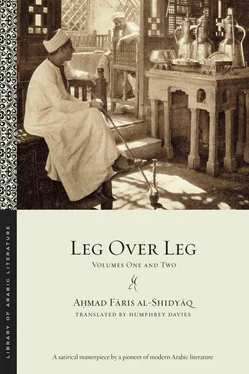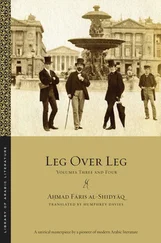Al-Shidyāq’s — and the Fāriyāq’s — steamship fare to England was, of course, paid by missionaries. The missionary presence in the Middle East, mostly American and British, began in Egypt and the eastern Mediterranean in the early nineteenth century and was aimed mainly toward the conversion of Eastern Christian sects such as the Maronites in Lebanon and the Copts in Egypt (and, to a lesser extent, Jewish Ottoman subjects). While they failed to convert many — in 1830, the entire “Protestant community” of the Ottoman empire reportedly consisted of six people 38—they did establish important institutions of learning and foster intellectual relationships with several influential literary figures. Yet missionary societies are just one example of international contact in the Middle East; far more influential and commonplace than the “Biblemen,” as they were sometimes called — or “bag-men,” as al-Shidyāq satirizes them, because they, like itinerant merchants, would hawk their wares in the spiritual marketplace — were European merchants and manufacturers, who appeared more often in the region during the nineteenth century.
During this period, economic ties between European countries and the larger Ottoman Empire (of which modern-day Syria and Lebanon were a part) deepened: beginning in the 1840s with a series of laws called the tanẓīmāt , Istanbul rapidly opened its empire to foreign investment and trade. In Egypt this meant that European banks began to establish themselves in Alexandria as early as the 1850s, lending money to the soon-to-be bankrupt Egyptian government. 39In Lebanon the consequence of these changes was the rapid growth in the export of agricultural products in the 1850s and 1860s; the silk-thread trade alone accounted for over eighty percent of the region’s exports to Europe. 40At the same time, the quantity of European manufactured goods consumed in the region increased: the Middle East became incorporated into the new world economic system as a dependent region, with prices and exports determined by demand in Europe, and with locally-based European merchants reaping much of the profit. 41
Foreign travel and immigration to the Middle East rose apace; the silk trade brought French capitalists and merchants (especially from Lyon) to Mount Lebanon to set up silk factories, and a booming cotton industry and transport construction lured workers and investors to Egypt. (The number of Europeans who came into Egypt alone rose from between 8,000 and 10,000 in 1838 to 30,000 in 1861 and 80,000 by 1865.) 42At the same time that foreign travel and immigration to the Middle East became more frequent, so did Arab migration and travel to Europe. While it was once a scholarly commonplace to consider Muslims and Arabs as generally uncurious about Europe — a view popularized, at least in academic contexts, by Bernard Lewis in Islam and the West and The Muslim Discovery of Europe —recent work has made lesser-known travelogues of the seventeenth through nineteenth centuries known and available to English readers. 43Putting this period’s travel literature into the long history of Arab contact with Europe makes it clear that there was no sudden nineteenth-century “discovery” of Europe.
Nonetheless, a new dimension to this contact emerged in the nineteenth century — national consolidation, with the goal of strengthening Arab scientific and military capabilities in the wake of European encroachment. After Napoleon’s short-lived occupation of Egypt, from 1798 to 1801, Egypt’s ruler, Muḥammad ʿAlī, launched his own scientific campaign to Europe by dispatching educational missions in various disciplines. 44First sending a group of students to Italy to train as printers and type-founders, he later sent missions to France and England to study shipbuilding, engineering, medicine, law, diplomacy, and languages. During what Muḥammad ʿAlī envisioned as a cultural and technical revival, these missions stood at the core of a national education project — as they not only brought home valuable skills and information, but also disseminated them through university teaching and the translation of technical textbooks. 45Printing presses, then, including the press that Napoleon brought to print his military bulletins and the still-operating Bulāq Press (founded in 1821), were instrumental to Muḥammad ʿAlī’s modernizing agenda, as they published official news and the scientific and academic works that Egyptian delegates translated upon their return.
Not all publishing, however, was produced in the service of the state. Any author could have a book printed at Muḥammad ʿAlī’s press, provided that the costs were paid, and private presses began to compete with state publishing houses for the emerging print market. 46By mid-century, there were more than a dozen presses operating in the Levant alone, with six privately owned commercial presses opening in the 1850s. 47In addition to missionary presses like the CMS Press in Malta, authors themselves also became printer-publishers, founding their own presses and publishing their own writing or journals. In Cairo, Alexandria, Beirut, Baghdad, Mosul, Aleppo, Damascus, Jerusalem, and Valletta, authors and translators published a range of texts for the emerging commercial market. 48The nineteenth-century Arabic print sphere emerged as one that was profoundly heterogeneous, producing editions of classical Arabic texts as well as translations from English and French literature. Alongside these, original Arabic prose works appeared, some in neoclassical style, and others written in a form called riwāyah , the word now used to mean “novel” but which then signified a category more fluid, such as “narrative” (literally, it is the verbal noun for “telling”), as well as works in between.
In doing so, the Nahḍah ’s print market forged new alliances, not simply within the imagined community of the nation, but intra-regionally — creating, in effect, something that could for the first time be called a public Arabic print sphere, where “the sounds from Beirut, Cairo, and Alexandria reached other Arab provinces, and educated groups in the towns of Syria, Palestine, Iraq, and even the Hejaz became involved in the new exchange in print across provincial boundaries.” 49Periodicals published in Beirut would advertise or review novels written by Egyptian colleagues, and journals of various affiliations would engage each other in debate about the correct use of Arabic, the relative merits of different literary translators, or editorial policy. The picture that emerges is of an Arabic print sphere that was intricately interlinked, making alliances across provincial borders, confessional boundaries, and even across continents. Early journals and newspapers were sometimes the product of either foreign investment (as was the case with the Franco-Egyptian ventures of L’Echo des Pyramides , 1827, and Al-Tanbīh , founded in 1800) or direct intellectual exchange, 50and featured an international news section often translated from European newspapers and wire services, thanks to the widespread use of the telegraph and the establishment of Reuters’s first office outside Europe, in Alexandria in 1865. 51Their audience, too, was international — composed not just of readers in Beirut or Cairo but also immigrant readers and Orientalists in Europe and, later, in North America. 52An English traveler to the Arabian Peninsula in the 1870s, Charles Montagu Doughty, remarked that al-Shidyāq’s Al-Jawāʾib was “current in all countries of the Arabic speech” and that he had seen it even “in the Nejd merchants’ houses at Bombay.” 53
The links established by trade and travel, then, were formed simultaneously in the print sphere, and it was there that they were debated. What was shared in print, perhaps even more than a sense of a bounded national or imperial space, was the Nahḍah reader’s relationship to the world around him, the sense both of being a local actor and participating in global phenomena. Indeed, by the end of the nineteenth century it was possible to see journalists referring an international or even global Nahḍah , consisting of Arab authors or litterateurs who traveled and published abroad. 54The Nahḍah , then, might be understood as an attempt to negotiate Arab modernity, identity, and enlightenment in the context of what authors identified as a new age of technological, social, literary, commercial, and even moral change, which they were joining by virtue of a new sense of global interconnectedness. 55One intellectual project that concerned the writers and thinkers of the Nahḍah , then, was how — and on what terms — to understand their participation in this global process. Debates about modernity, oriented toward the issue of tamaddun (loosely translated as “progress toward civilization”), emerged. Journalistic essays asked, “Who are we?” as a way to seek answers to the larger question of what it means to be Arab (and not necessarily an Egyptian or a Lebanese) and modern, or Arab and enlightened, in the cross-currents of global capitalism, empire, and the trans-regional and potentially global community of the faithful, the umma . 56To do so was to demarcate local specificity within the global, rather than against it. Thus Nahḍah intellectuals did not necessarily seek either to preserve or to abandon authentic traditions in the face of foreign encroachment. The common understanding of the choice intellectuals made, between the position of “reformer” and “reactionary,” might be a false dichotomy. As Shaden Tageldin writes, “For most of the elite Egyptian intellectuals of the Nahḍah , becoming modern was never a question of abandoning Arabic and writing in the languages of their European colonizers — in French or English. The Nahḍah unfolded in translation: it transported French or English into Arabic. Thus it appeared to ‘preserve’ Arabic — all the while translating it.” 57In other words, these intellectuals theorized modernity as a comparative project, as something taking shape alongside Europe. 58
Читать дальше












